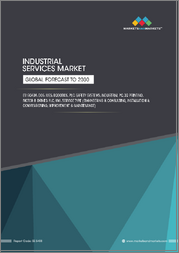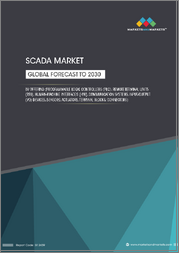
|
시장보고서
상품코드
1610860
SCADA 시장 규모, 점유율, 성장 분석 : 제공별, 구성요소별, 용도별, 지역별 - 산업 예측(2024-2031년)SCADA Market Size, Share, Growth Analysis, By Offering (Hardware, Software), By Component, By Application, By Region - Industry Forecast 2024-2031 |
||||||
SCADA 세계 시장 규모는 2022년 383억 달러로 평가되며, 2023년 421억 달러에서 2031년 845억 달러로 성장하여 예측 기간(2024-2031년) 동안 9.1%의 CAGR로 성장할 것으로 예상됩니다.
SCADA 시장은 석유 및 가스, 유틸리티, 수자원 관리 등의 분야에서 실시간 모니터링 및 제어를 통한 업무 효율성 향상을 위한 자동화 요구가 증가함에 따라 크게 성장하고 있습니다. 인더스트리 4.0에서 AI, IoT, 클라우드 컴퓨팅과 같은 첨단 기술의 통합은 SCADA 시스템을 보다 지능적이고 유연한 솔루션으로 변화시키고 있습니다. 그러나 높은 초기 투자 비용과 시스템 업그레이드의 복잡성 등의 과제는 여전히 남아 있으며, COVID-19 팬데믹은 초기에는 업계 가동 중단과 자금 조달 문제로 인해 성장을 저해했습니다. 하지만 장기적인 전망은 밝습니다. 원격 근무로의 전환과 인적 교류의 최소화로 인해 기업은 SCADA 기술을 채택할 수밖에 없으며, 이는 스마트 개발 사무실과 자동화 영역의 시장 발전과 혁신을 촉진할 것이기 때문입니다.
목차
소개
- 조사 목적
- 조사 범위
- 정의
조사 방법
- 정보 조달
- 2차 데이터와 1차 데이터 방법
- 시장 규모 예측
- 시장 가정과 제한
주요 요약
- 세계 시장 전망
- 공급과 수요 동향 분석
- 부문별 기회 분석
시장 역학과 전망
- 시장 개요
- 시장 규모
- 시장 역학
- 성장 촉진요인과 기회
- 성장 억제요인과 과제
- Porters 분석과 영향
- 경쟁 기업 간의 경쟁 관계
- 대체품의 위협
- 구매자의 교섭력
- 신규 참여업체의 위협
- 공급 기업의 교섭력
주요 시장 인사이트
- 핵심성공요인
- 경쟁 정도
- 주요 투자 기회
- 시장 생태계
- 시장 매력 지수(2023년)
- PESTEL 분석
- 거시경제 지표
- 밸류체인 분석
- 가격 분석
- 기술의 진보
- 규제 상황
- 사례 연구
- 특허 분석
SCADA 시장 규모 : 제공별 & CAGR(2024-2031)
- 시장 개요
- 하드웨어
- 소프트웨어
- 서비스
SCADA 시장 규모 : 구성요소별 & CAGR(2024-2031)
- 시장 개요
- 휴먼 머신 인터페이스
- 프로그래머블 로직 컨트롤러
- 원격 터미널 버스
- 기타
SCADA 시장 규모 : 용도별 & CAGR(2024-2031)
- 시장 개요
- 화학 및 의약품
- 식품 및 음료
- 제조업
- 석유 및 가스
SCADA 시장 규모 : 지역별 & CAGR(2024-2031)
- 북미
- 미국
- 캐나다
- 유럽
- 영국
- 독일
- 스페인
- 프랑스
- 이탈리아
- 기타 유럽
- 아시아태평양
- 중국
- 인도
- 일본
- 한국
- 기타 아시아태평양
- 라틴아메리카
- 브라질
- 기타 라틴아메리카
- 중동 및 아프리카
- GCC 국가
- 남아프리카공화국
- 기타 중동 및 아프리카
경쟁 정보
- 상위 5개사의 비교
- 주요 기업의 시장 포지셔닝(2023년)
- 주요 시장 기업이 채용한 전략
- 시장의 최근 동향
- 기업의 시장 점유율 분석(2023년)
- 주요 기업 개요
- 기업 개요
- 제품 포트폴리오 분석
- 부문별 점유율 분석
- 매출 전년비 비교(2021-2023)
주요 기업 개요
- ABB Ltd.(Switzerland)
- Emerson Electric Co.(United States)
- Rockwell Automation Inc.(United States)
- Schneider Electric SE(France)
- Siemens AG(Germany)
- GE(United States)
- Honeywell International Inc.(United States)
- Yokogawa Electric Corporation(Japan)
- Omron Corporation(Japan)
- Inductive Automation(United States)
- AVEVA(United Kingdom)
- Iconics Inc.(United States)
- Elynx Technologies LLC(United States)
- Enbase LLC(United States)
- Globalogix(United States)
- COPA-DATA(Austria)
- Softing Industrial Automation(Germany)
- Citect(Australia)
- Proficy(United States)
- WinCC(Germany)
결론과 추천사항
ksm 24.12.23Global SCADA Market size was valued at USD 38.3 billion in 2022 and is poised to grow from USD 42.1 billion in 2023 to USD 84.5 billion by 2031, growing at a CAGR of 9.1% during the forecast period (2024-2031).
The SCADA market is witnessing substantial growth driven by the increasing automation needs across sectors such as oil and gas, utilities, and water management, aimed at enhancing operational efficiency through real-time monitoring and control. The integration of advanced technologies like AI, IoT, and cloud computing under Industry 4.0 is transforming SCADA systems into more intelligent and flexible solutions. However, challenges such as high initial investments and complexities in system upgrades persist. The COVID-19 pandemic initially hindered growth due to industry shutdowns and cash flow issues. Nevertheless, the long-term outlook is positive, as the shift toward remote work and minimized human interaction is compelling businesses to adopt SCADA technologies, thus propelling market advancement and innovation in smart development offices and automated regions.
Top-down and bottom-up approaches were used to estimate and validate the size of the Global Scada market and to estimate the size of various other dependent submarkets. The research methodology used to estimate the market size includes the following details: The key players in the market were identified through secondary research, and their market shares in the respective regions were determined through primary and secondary research. This entire procedure includes the study of the annual and financial reports of the top market players and extensive interviews for key insights from industry leaders such as CEOs, VPs, directors, and marketing executives. All percentage shares split, and breakdowns were determined using secondary sources and verified through Primary sources. All possible parameters that affect the markets covered in this research study have been accounted for, viewed in extensive detail, verified through primary research, and analyzed to get the final quantitative and qualitative data.
Global Scada Market Segmental Analysis
Global SCADA Market is segmented by Offering, Component, Application and Region. Based on Offering, the market is segmented into Hardware, Software, Services. Based on Component, the market is segmented into Human Machine Interface, Programmable Logic Controller, Remote Terminal Units Based on Application, the market is segmented into Chemical and Pharmaceuticals, Food and Beverage, Manufacturing, Oil and Gas. Based on Region, the market is segmented into North America, Europe, Asia Pacific, Latin America and Middle East & and Africa.
Driver of the Global Scada Market
The global SCADA market is propelled by the increasing demand for automation across various industrial sectors, including oil and gas, power generation, construction, and water treatment. This trend significantly boosts productivity while minimizing human error and improving real-time monitoring of intricate systems. SCADA systems are essential in streamlining industrial operations, offering capabilities such as real-time feedback, remote monitoring, and predictive maintenance. As industries strive for enhanced efficiency, safety, and accuracy in their applications, the widespread adoption of SCADA solutions is becoming more prevalent, ultimately impacting the market's growth on a global scale.
Restraints in the Global Scada Market
One of the major challenges facing the global SCADA market is the significant high start-up costs associated with initial implementation. The deployment of SCADA systems necessitates substantial investments in hardware, software, and skilled personnel for installation and ongoing maintenance. This financial strain is particularly daunting for small and medium-sized enterprises (SMEs), which often lack the resources to manage such high expenditures. Additionally, the complexity and expense of integrating SCADA systems with existing legacy infrastructure further hinder market growth among smaller players. These factors collectively create substantial barriers that restrict the adoption of SCADA technologies across the industry.
Market Trends of the Global Scada Market
The Global SCADA market is experiencing a significant transformation as businesses pivot towards cloud-based SCADA solutions, driven by the demand for improved scalability, flexibility, and cost-efficiency. This trend allows organizations to streamline operations by lowering transaction costs and enabling real-time data monitoring and management from any location. As digital transformation accelerates across various industries, the adoption of cloud-centric SCADA platforms has surged, emerging as a preferred choice for enterprises seeking enhanced performance and reduced infrastructure expenditures. This shift not only optimizes operational efficiency but also aligns with the growing trend of remote accessibility, establishing cloud-based SCADA as a pivotal element of modern industrial automation.
Table of Contents
Introduction
- Objectives of the Study
- Scope of the Report
- Definitions
Research Methodology
- Information Procurement
- Secondary & Primary Data Methods
- Market Size Estimation
- Market Assumptions & Limitations
Executive Summary
- Global Market Outlook
- Supply & Demand Trend Analysis
- Segmental Opportunity Analysis
Market Dynamics & Outlook
- Market Overview
- Market Size
- Market Dynamics
- Driver & Opportunities
- Restraints & Challenges
- Porters Analysis & Impact
- Competitive rivalry
- Threat of substitute
- Bargaining power of buyers
- Threat of new entrants
- Bargaining power of suppliers
Key Market Insights
- Key Success Factors
- Degree of Competition
- Top Investment Pockets
- Market Ecosystem
- Market Attractiveness Index, 2023
- PESTEL Analysis
- Macro-Economic Indicators
- Value Chain Analysis
- Pricing Analysis
- Technological Advancement
- Regulatory Landscape
- Case Studies
- Patent Analysis
SCADA Market Size by Offering & CAGR (2024-2031)
- Market Overview
- Hardware
- Software
- Services
SCADA Market Size by Component & CAGR (2024-2031)
- Market Overview
- Human Machine Interface
- Programmable Logic Controller
- Remote Terminal Bus
- Others
SCADA Market Size by Application & CAGR (2024-2031)
- Market Overview
- Chemical and Pharmaceuticals
- Food and beverage
- Manufacturing
- Oil and Gas
SCADA Market Size & CAGR (2024-2031)
- North America, (Offering, Component, Application)
- US
- Canada
- Europe, (Offering, Component, Application)
- UK
- Germany
- Spain
- France
- Italy
- Rest of Europe
- Asia-Pacific, (Offering, Component, Application l)
- China
- India
- Japan
- South Korea
- Rest of Asia Pacific
- Latin America, (Offering, Component, Application)
- Brazil
- Rest of Latin America
- Middle East & Africa (Offering, Component, Application)
- GCC Countries
- South Africa
- Rest of Middle East & Africa
Competitive Intelligence
- Top 5 Player Comparison
- Market Positioning of Key Players, 2023
- Strategies Adopted by Key Market Players
- Recent Developments in the Market
- Company Market Share Analysis, 2023
- Company Profiles of All Key Players
- Company Details
- Product Portfolio Analysis
- Company's Segmental Share Analysis
- Revenue Y-O-Y Comparison (2021-2023)
Key Company Profiles
- ABB Ltd. (Switzerland)
- Company Overview
- Business Segment Overview
- Financial Updates
- Key Developments
- Emerson Electric Co. (United States)
- Company Overview
- Business Segment Overview
- Financial Updates
- Key Developments
- Rockwell Automation Inc. (United States)
- Company Overview
- Business Segment Overview
- Financial Updates
- Key Developments
- Schneider Electric SE (France)
- Company Overview
- Business Segment Overview
- Financial Updates
- Key Developments
- Siemens AG (Germany)
- Company Overview
- Business Segment Overview
- Financial Updates
- Key Developments
- GE (United States)
- Company Overview
- Business Segment Overview
- Financial Updates
- Key Developments
- Honeywell International Inc. (United States)
- Company Overview
- Business Segment Overview
- Financial Updates
- Key Developments
- Yokogawa Electric Corporation (Japan)
- Company Overview
- Business Segment Overview
- Financial Updates
- Key Developments
- Omron Corporation (Japan)
- Company Overview
- Business Segment Overview
- Financial Updates
- Key Developments
- Inductive Automation (United States)
- Company Overview
- Business Segment Overview
- Financial Updates
- Key Developments
- AVEVA (United Kingdom)
- Company Overview
- Business Segment Overview
- Financial Updates
- Key Developments
- Iconics Inc. (United States)
- Company Overview
- Business Segment Overview
- Financial Updates
- Key Developments
- Elynx Technologies LLC (United States)
- Company Overview
- Business Segment Overview
- Financial Updates
- Key Developments
- Enbase LLC (United States)
- Company Overview
- Business Segment Overview
- Financial Updates
- Key Developments
- Globalogix (United States)
- Company Overview
- Business Segment Overview
- Financial Updates
- Key Developments
- COPA-DATA (Austria)
- Company Overview
- Business Segment Overview
- Financial Updates
- Key Developments
- Softing Industrial Automation (Germany)
- Company Overview
- Business Segment Overview
- Financial Updates
- Key Developments
- Citect (Australia)
- Company Overview
- Business Segment Overview
- Financial Updates
- Key Developments
- Proficy (United States)
- Company Overview
- Business Segment Overview
- Financial Updates
- Key Developments
- WinCC (Germany)
- Company Overview
- Business Segment Overview
- Financial Updates
- Key Developments



















